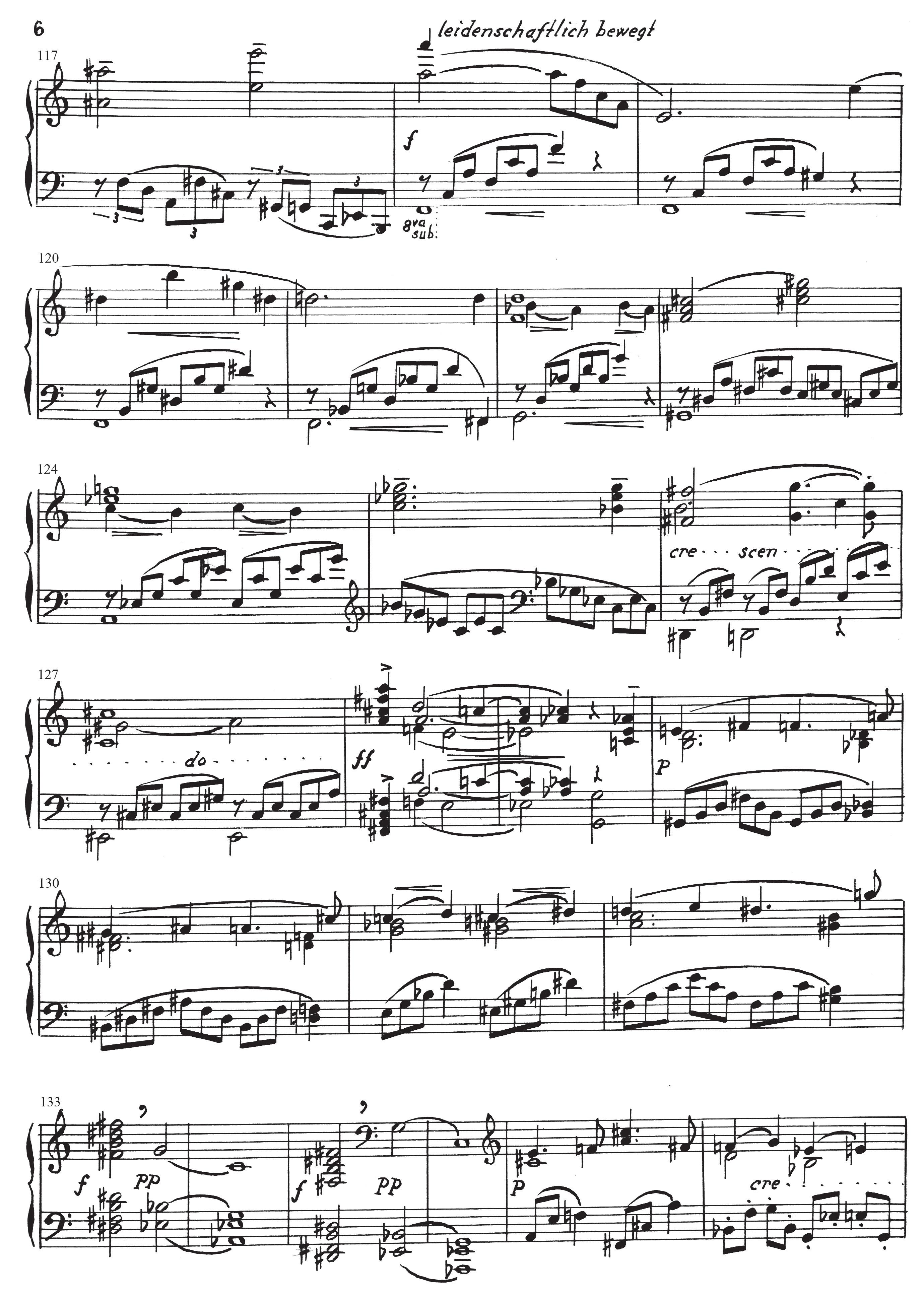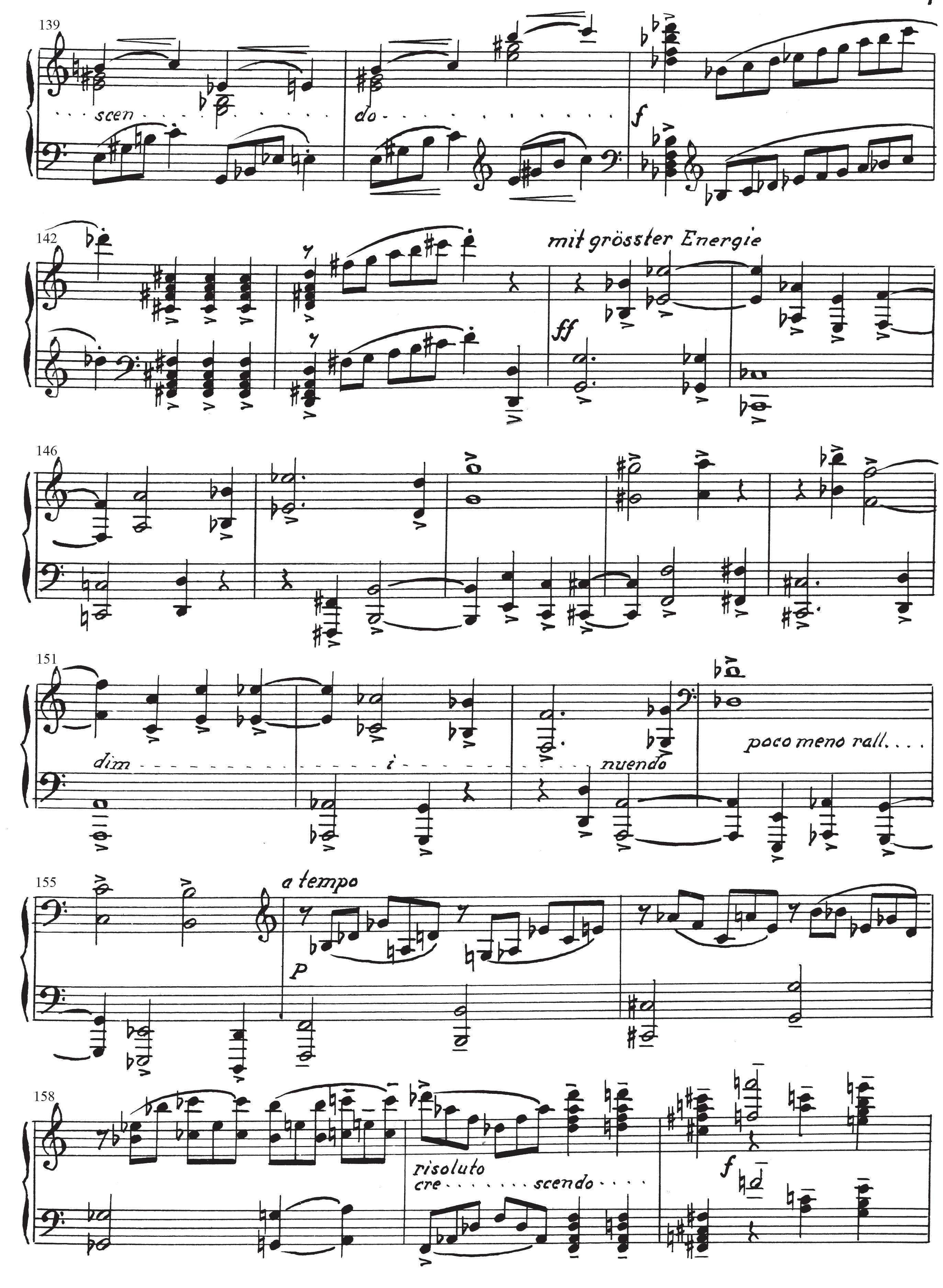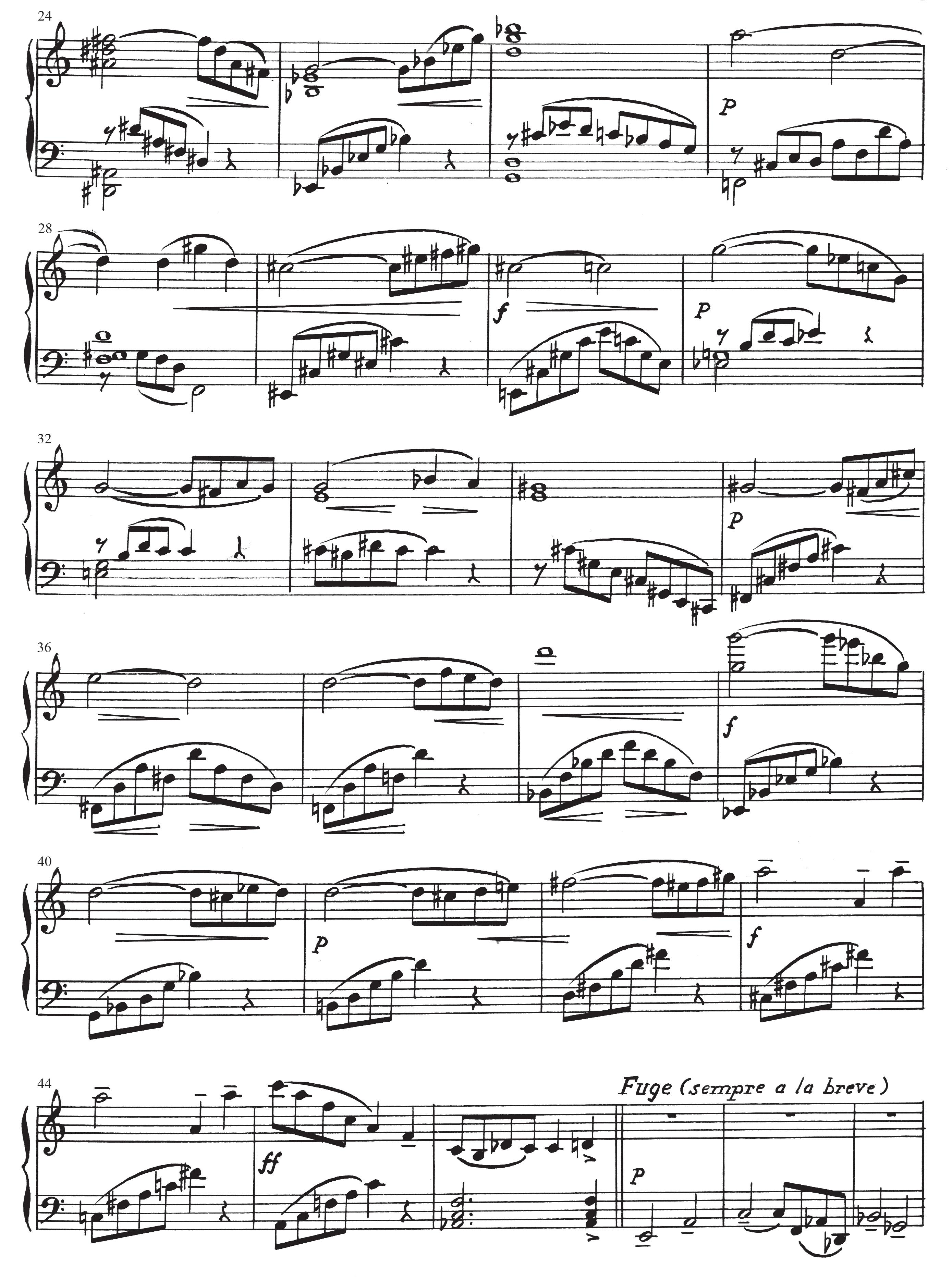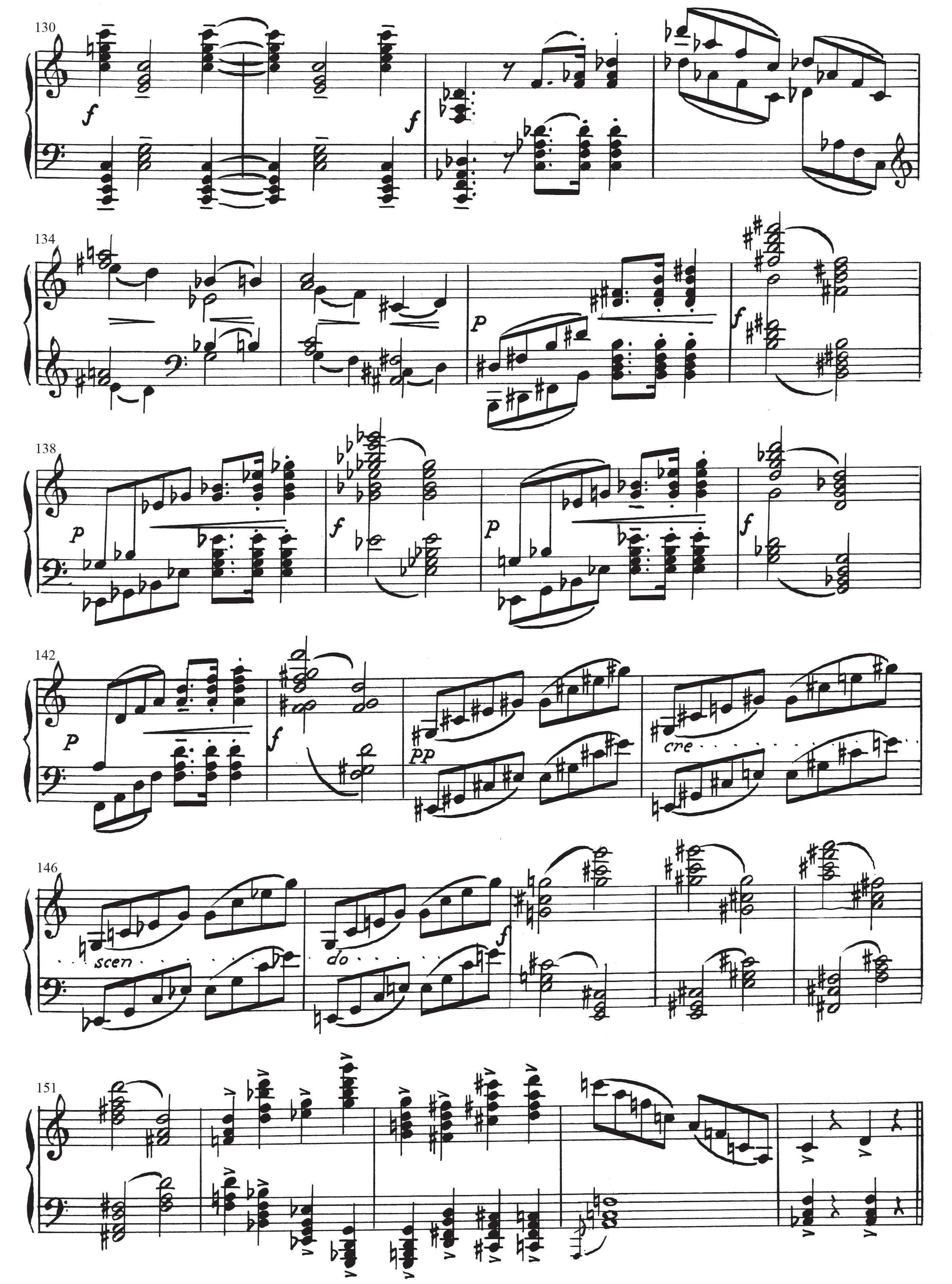PAUL VON KLENAU
SONATE FOR KLAVER F-MOL
SONATA FOR PIANO F MINOR

SONATE FOR KLAVER F-MOL
SONATA FOR PIANO F MINOR
SONATE FOR KLAVER F-MOL
SONATA FOR PIANO F MINOR
UDGIVET AF
EDITED BY
LISBETH AHLGREN JENSEN
Cover design
Music
DCM
ISMN
Distribution © 2010
Willerup & Based on a scanned dyeline print, 1944
001
979-0-9001824-0-1
Dansk Center for Musikudgivelse (DCM), København Danish Centre for Music Publication, The Royal Library, Copenhagen
PAUL VON KLENAU
Paul von Klenau (1883-1946) var født i København men tilbragte størstedelen af sit voksne liv i Tyskland og Østrig. Han studerede først musikteori og violinspil i København og rejste herpå i 1902 til Berlin for at studere komposition hos Max Bruch og violin hos Carl Halír. Fra 1904 fortsatte han kompositionsstudierne i München hos Ludwig Thuille, og fra 1908 tog han undervisning hos Max von Schillings i Stuttgart. I årene 1907-14 bestred han forskellige poster som kapelmester og repetitør ved teatre i Tyskland, hvor han endelig i 1913 ansattes som første kapelmester ved operaen i Freiburg. Fra 1919 arrangerede Klenau tillige koncerter i København, og han var i 1920 medstifter og indtil 1926 leder af Dansk Filharmonisk Selskab. Her opførtes moderne orkestermusik af alle retninger; i 1923 kunne han endog præsentere Arnold Schönberg, der dirigerede en koncert med egne værker. Sideløbende med engagementer som dirigent i Wien fra 1922 virkede Klenau indtil 1930 som kordirigent ved Konzerthausgesellschaft. Han udnævntes i 1929 til professor og havde som dirigent og komponist Frankfurt og Wien som sine faste holdepunkter, indtil han i vinteren 1939-40 vendte tilbage til Danmark, hvor han døde i 1946. Klenaus musikalske produktion omfatter musik i næsten alle genrer: operaer, symfonier, instrumentalkoncerter, kammermusik, klavermusik og sange. Hertil kommer, at han skrev en række musiklitterære artikler, ligesom han holdt foredrag.
Klenaus samling i Det Kongelige Bibliotek
Det Kongelige Bibliotek købte i 2005 en meget stor samling af Klenau-manuskripter.
Samlingen havde gennem mere end 30 år ligget ukendt og ubenyttet, dels i et sommerhus i Tyrol, dels i en herskabslejlighed i Wien og indeholder en række værker af Paul von Klenau, som ikke kendes fra andre kilder. Enkelte af værkerne blev opført ved en Klenau portrætkoncert i Dronningesalen i maj 2008. Langt størstedelen af det store materiale er endnu ikke gennemarbejdet.
Klenaus klavermusik
Klenaus klavermusik omfatter en række afsluttede værker, der fordeler sig over hele hans produktive periode. Tidligst komponerede han de to klaversonater i Es- dur og E-dur, der ligesom de to sene arbejder, Sonate i f-mol og Sonatine i E-dur, forblev utrykt. De øvrige klaverværker tæller samlingerne Barndoms-Minder og Geschichten von der Vierjährigen, der blandt andet rummer en fantasi over den danske børnesang ”Tingelingelater, Tinsoldater”, Klein Ida-Walzer, der er komponeret på grundlag af motiver fra Klenaus balletmusik til H.C. Andersens eventyr ”Den lille Idas Blomster”, samlingerne Drei Stimmungen og Vier Klavierstücke samt to hefter med hver seks Præludier og Fugaer i 12 forskellige tonearter.
Sonate i f-mol
Det forhold, at sonaten i f-mol og sonatinen i E-dur er overleveret i lystryk med copyright-angivelsen 1944, kunne tyde på, at Klenau planlagde en udgivelse af dem, men af ukendte årsager blev de ikke publiceret. Begge sonater bygger på det i samtidens danske musikliv forkætrede tolvtoneprincip, som komponisten anså for at være en væsentlig udvidelse og berigelse af de musikalske udtryksmidler. Tolvtonemusikken betød efter hans mening ikke et brud med den harmonilære, der byggede på dur-mol-tonaliteten, og det var et vigtigt anliggende for ham at vise, at man kunne komponere lytteværdig tolvtonemusik, hvad han blandt andet realiserede i tre store operaer, opført på tyske scener i 1930’erne. Sonaten i f-mol, der ligesom sonatinen i E-dur er et eksempel på hans såkaldte ”toneartsbestemte” tolvtonemusik, er i fire satser. Begge indgår i den samling af Klenaus trykte noder, manuskripter og personalia, Det Kongelige Bibliotek købte i 2005, og udgives i Dansk Center for Musikudgivelse.
Lisbeth Ahlgren Jensen
Paul von Klenau (1883-1946) was born in Copenhagen but spent most of his life in Germany and Austria. Klenau originally studied music theory and violin in Copenhagen, and in 1902 he travelled to Berlin to study composition with Max Bruch and violin with Carl Halír. From 1904 he took composition lessons in Stuttgart with Max von Schillings. During the period between 1907 and 1914 he was engaged as conductor and rehearser at various German theatres, and in 1913 he was employed as chief conductor at the Freiburg Opera. In addition Klenau organised concerts in Copenhagen from 1919, and in 1920 he became co-founder – and until 1926 leader –of The Danish Philharmonic Society. Here modern orchestral music of all kinds was performed; in 1923 he even managed to introduce Arnold Schönberg, who conducted a concert with his own works. Parallel with engagements as a conductor in Vienna from 1922, Klenau also worked as choral conductor at the Konzerthausgesellschaft. In 1929 he was made a professor, and as a conductor and composer he held Frankfurt and Vienna as his fixed points, until in the winter of 1939-40 he returned home to Denmark, where he died in 1946. Klenau’s musical production covers almost all genres: operas, symphonies, instrumental concerts, chamber music, piano music and songs. To this should be added that he wrote a great number of articles on musical subjects, some of which were also given as talks in various places and connections.
Klenau’s collection at The Royal Library
In 2005 The Royal Library bought a large collection of manuscripts by Klenau. During the previous more than thirty years the manuscripts had been kept in a summer house in Tyrol and a flat in Vienna. The collection contains a number of works by the Danish composer Paul von Klenau that are not known from other sources. A few of these works were given their first Danish performance at a concert in the library in May 2008. The material has so far only received scant attention.
Paul von Klenau’s Piano Music
Klenau’s piano music consists of a number of completed works, covering his whole period as an active composer. Klenau wrote four piano sonatas and sonatines: two of them date from his early period (Sonatas in E flat major and E major), and two works from his more mature years (Sonata in F minor and Sonatine in E major). His other piano works are: Barndoms-Minder (Childhood Memories); Geschichten von der Vierjährigen (Stories of a Four-Year Old), which among other pieces contains a phantasy on the Danish children’s song “Tingelingelater, Tinsoldater”; Klein Ida-Walzer (Little Ida’s Waltz) based on themes from Klenau’s music to the ballet on Hans Christian Andersen’s fairy tale “The Flowers of Little Ida”; Drei Stimmungen (Three Sentiments), Vier Klavierstücke (Four piano pieces); two volumes containing preludes and fugues in twelve different keys.
The fact that the Sonata in F minor and the Sonatina in E major are handed down as dyeline prints, copyrighted in 1944, indicates that Klenau originally planned to have them published, but for unknown reasons this never happened. Both sonatas are based on the dodecaphonic technique, which in those days was highly controversial in Danish musical circles, but which the composer considered an important increase in and enrichment of the musical means of expression. According to Klenau, 12-note serial composition did not indicate a break away from the theory of harmony based on major/minor tonality, and it was important for him to show that it was possible to compose 12note serial music worth listening to. This he also showed in three grand operas, performed on German stages in the 1930s.
The Sonata in F minor, which like the Sonatina in E major is an example of his so-called “12-note serial composition in a fixed key”, is in four movements. Both works are included in the collection of music, manuscripts and personal material, which were bought by The Royal Library in 2005. The two works are published by Danish Centre for Music Publication.
Lisbeth Ahlgren Jensen






















DESCRIPTION OF SOURCES
A Score, dyeline print
B Score, autograph
A Score, dyeline print.
DK-Kk, Paul v. Klenaus Samling No. 136.
Title on first music page: “SONATE, F MOL / Paul von Klenau 1943” [printed in gold].
30x22.5 cm, dyeline print, 22 numbered pages, not stabled. Few additions in pencil; p. 1 cut in two between second and third systems.
“Copyright 1944 / by Professor Paul von Klenau / A/S Dansk Lyskopi”.
B Score, autograph.
DK-Kk, Paul v. Klenaus Samling No. 136.
Title on first music page: “Sonate, f moll / für / Klavier. / Paul v. Klenau”.
34.4x26.7 cm, five bifolios, numbered 1-19, one unnumbered page; written in ink, additions in pencil and blue crayon, not stabled. Includes a separate slip (c.13.1x26.8 cm, written in pencil) with corrections to p. 19, fifth system, bb. 3, 5.
Paper: “Beethoven Papier Nr. 35 (20 Linien) 1942” (20 staves). Fourth movement written before third movement. “Frederiksen: se Side 19” (Frederiksen, please look at p. 19) added in pencil above top stave of p. 16. A number of bars cancelled, and an alternative version of the final bars written on p. 19, and the first bars of the third movement written on pp. 16-17.
FILIATION AND LIST OF EDITORIAL EMENDATIONS AND ALTERNATIVE READINGS
The dyeline print (A), which was copyrighted in 1944, has been elected as copy text for the present edition. It was proofread and revised by the composer, but apparently not published during his lifetime (1883-1946). In connection with the proofreading, Klenau made a number of revisions (mainly in blue crayon) in the autograph fair copy (B), on which the dyeline copy was based, e.g. changes in articulation, change of chord positions, and additions of accidentals. Most of the revisions were included in A and are therefore part of the present edition; some of them, however – written either in pencil or in blue crayon – are not included in A, either because they were forgotten or because Klenau may have regretted them. Finally, some revisions are made directly in A without the composer afterwards having them added to B. In these cases the present edition follows A. Klenau’s use of articulation and accidentals needs a special comment. Thus, for the four introductory bars of the sonata, which present the 12-note series in unison, Klenau adds only one slur, though the phrase is written for two parts with both up-
wards- and downwards stems. This also goes for the transposed and incomplete series in bb. 5-7. In the following, unison bars, however, he adds a slur for each of the parts. The same inconsistency is observed concerning accidentals; the principle seems to be that an accidental is valid only in the very octave and in the very part in which it is added; on the other hand, a cautionary accidental is often added in a different part or in a different octave from the one in which the altered note occurred. However, it seems to be a principle – not necessarily used in every case – that accidentals are not to be repeated for notes tied to a previous note following a bar line. Finally, it should be emphasized that Klenau’s piano notation is not bound to strict part writing and that some parts are thus defective; hence, sometimes the same phrase may be notated with a different use of stem direction.
In the present edition, errors have been emended (e.g. pitches), and articulation and dynamics have been added partly with reference to B and partly by analogy with parallel instances in A. No revision has been made in those instances in which the editor has not been able to fully interpret an addition in B; however, the addition is registered as a variant. The editor has tacitly omitted superfluous accidentals and added a number of cautionary ones in accordance with an understanding of Klenau’s practice; accidentals, which imply a change of pitch, are in all cases followed by a comment. No attempt has been made to adjust the composer’s part writing, and only incomplete bars (not incomplete parts) are emended as to the missing note values. Information about the writing utensils in the sources may reveal the different “layers” of the sources when it comes to changes and revisions.
Bar numbers are added by the editor. The present edition is based on a scanned version of A, revised by means of image editing software
10 pf.1 first crotchet (bottom note): stacc. added by analogy with upper note
11 pf.2 B: last chord: marc. added in pencil
12
13
pf.2 B: chords 1-2: marc. added in pencil
pf.2 B: chord 1: marc. added in pencil
16 pf.2 chord 4: marc. added by analogy with pf.1 and b.57
17 pf.2 chord 1: marc. added by analogy with pf.2 and b.58 (note 1)
17 pf.1 chord 2, lower part of chord: marc. added by analogy with upper part of chord
26 Espressivo (leidenschaftlich, nicht weichlich) added as in B; B: above system: “Espressivo (leidenschaftlich, nicht weichlich) / Espressivo (LEIDENSCHAFTLICH, NICHT WEICHLICH)”
29 pf.2 fourth crotchet (upper part): 4-rest added; (B: bar incomplete)
33 pf.1 chord 1: b emended to b by analogy with pf.2 (note 3)
50 pf.1, 2 f added because of crescendo bb.47-49 and as in B
58 pf.1 chord 2, lower part of chord: marc. added by analogy with upper part of chord
65 above system: tempo emended to a tempo by analogy with b.156
66 above system: (a tre battute) emended to (a tre battùte) according to correction in A
66 pf.1 pp added by analogy with b.65 (pf.2, note 3) and as in B
71 pf.1
78, 80 pf.1
78 pf.2
80 pf.2
81 pf.1
82, 84 pf.1
82 pf.2
83, 85 pf.1
note 2: stacc. added as in B
B: chords 1-3, 4-6: slurs crossed out in blue crayon
B: chords 1-3, 4-6: slurs
B: chords 1-3, 4-6: slurs erased
B: notes 1-9: slur crossed out in blue crayon
B: chords 1-3, 4-6: slurs crossed out in blue crayon
B: slurs crossed out in black ink
B: notes 1-9: slur
87 pf.1,2 note 11: added ( g fitting the structure of the 12-note series correctly)
88 pf.2
88, 90,
92 pf.1
90 pf.2
92 pf.2
93 pf.1
94 pf.1,2
98 pf.1
B: chords 1-3, 4-6: slurs
B: chords 1-3, 4-6: slurs crossed out in blue crayon
B: chords 1-6:
chords 1-3, 4-6: slurs crossed out in black ink
B: chords 1-3, 4-6: slurs crossed out in blue crayon
B: crossed out
B: chords 1-3, 4-6: slurs crossed out in blue crayon and black ink
B: chords 3, 4, 6 (lower notes) and chords 5, 7 (upper notes): crossed out in red crayon; fourth crotchet: ten. added in blue crayon
99 pf.1,2 note 1: marc. and notes 1-6: slurs added by analogy with b.159 and as in B
99 pf.1
102-105 pf.1
B: note 1: marc. added in blue crayon
B: chords 1-3: ten. changed to marc. in blue crayon
102 pf.2 sub---- added by analogy with bb.103-105 and as in B
106, 107 pf.1,2
108, 110 pf.1,2
B: chords 1-4: ten. changed to marc. in blue crayon
B: chords 1-3, 4-6: slurs crossed out in blue crayon
110 pf.1,2 chords 1, 3-4, 6: stacc. added by analogy with b.108 and as in B
110 pf.2
112,114 pf.1,2
B: chords 1-6: f, c
B: chords 1-3, 4-6: slurs crossed out in blue crayon
114 pf.2 notes 1, 3-4, 6: stacc. added by analogy with b. 108 and as in B
117 pf.2
B: notes 8-10: marc. added in black ink and emphasized in blue crayon
131 pf.2 note 7: b emended to b by analogy with pf.1
139 pf.1
B: third crotchet: g, b , e , a
144-145 mit grösster Energi emended to mit grösster Energie
144 pf.1
144 pf.2
B: chords 1-2: ten. changed to marc. in blue crayon
B: chord 1: ten. and marc. changed to marc. in blue crayon; chord 2: ten. changed to marc. in blue crayon
145 pf.1 chords 2-4: marc. added by analogy with b.148 (pf.2) and as in B; B: chords 2-4: ten. changed to marc. in blue crayon
146 pf.1
147, 148 pf.1,2
174 pf.1
178-179 pf.2
B: chord 3: ten. and marc. changed to marc. in blue crayon
B: ten. and marc. changed to marc. in blue crayon
B: chord 4: a , d , f
b.178 note 1 to b. 179 note 1: slur added by analogy with pf. 1
185- end-dating below the system: “16/ Juli/ 43”
II
Bar Part Comment
11 pf.1
19 pf.1
20 pf.2
A: fourth crotchet, note 3: e emended to e in pencil
B: p corrected to pp in pencil
B: added in pencil in margin: “Prikker over til e’et” (dots to be drawn to the e)
30 pf.1,2 B: third crotchet: p crossed out in pencil
31 pf.1,2
36 pf.2
B: third crotchet: f
B (upper part): note 2: ten.
47 pf.1 third crotchet note 2: b emended to b by analogy with note 2 chord 1
Bar Part Comment
B: above system: “Allegretto ( = 72 84) / Variation über eine Klassische Form.” added in black ink
5 pf.2 stacc. added by analogy with bb.4,6 and as in B
40II pf.2 added; A, B: bar empty
58 pf.2
60 pf.2
IV
B: stacc.
B: c, a
Bar Part Comment
B: addition in pencil at top of page: “Fredriksen 3die Del se Side 16” (Frederiksen, see Part 3 on p. 16); above system: number of movement indicated as “IIII”; “Presto” before “( = 88)” crossed out, “Allegro molto” added in pencil; time signature, , added in pencil
1 pf.2
1 pf.1,2
A: chord 1: A changed to A in pencil
B:
5 pf.1
B: chords 2-3: slur
7 pf.1 chord 1, lower part of chord: stacc. added by analogy with upper part of chord
8 pf.1 chord 3 (top note): b emended to b by analogy with bottom note
8 pf.2 chord 3: B emended to B by analogy with pf.1 (bottom note)
12 pf.1 note 1 (lower part): emended to by analogy with b.14 and as in B
20 pf.1 note 6: a emended to a by analogy with pf.2
23 pf.2
24, 25,
43 pf.2
B: note 5:
B: third crotchet: (bar incomplete)
44 pf.2 added; A, B: bar incomplete
72 pf.1
78 pf.2
B: fourth crotchet: 4 2 (fingering) added in pencil
A: note 3: E changed to E in pencil
82 pf.1 note 3 (upper part): g emended to f by analogy with the melodic movement in bb.80-81, 83 and as in B
84 pf.1,2 B: ff corrected to fff or f in blue crayon (illegible)
90 pf.2 chord 1: e emended from f by analogy with pf.1 as in B; A: below the system: pencil marc added
107 pf.1 note 5: d emended to c by analogy with the triads in bb.108-109 and as in B
118 pf.2 chord 4: stacc. added by analogy with pf.1 and as in B
120 pf.1 first crotchet, lower part of chord 1: stacc. added by analogy with upper part of chord and as in B
124-125 pf.1,2
B: b.124 note 2 to b.125 note 2: crossed out in blue crayon
125 pf.1 note 1 (lower part): emended to by analogy with pf.2 and as in B
136 pf.1
136, 138 pf.1,2
148 pf.1
B: notes 1-4: slur crossed out in blue crayon
B: third crotchet: slur and ten. above note 1 crossed out in blue crayon
B: chord 1: notated an octave lower with with the addition of sub; chord 2: notated an octave lower with the addition of ; B (separate slip): written as in A
148 pf.2
B: chord 1: written an octave lower with the addition of ; chord 2: written an octave lower with the addition of sub; B (separate slip): written as in A
157 pf.1 notes 3-5: ten. added as in B; B: notes 3-5: ten. emphasized in blue crayon
172 pf.1 B (upper part): notes 1-2: ten. and marc.
191 vorwärtz emended to vorwärts
194 B: above system: “Prestissimo.” changed to “Presto” in pencil
194 pf.1,2 B: third crotchet: slur crossed out in blue crayon
215 B: ff